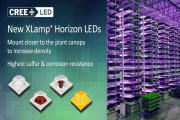Researchers from University of Illinois have utilized an epitaxial approach to develop a 3-D photonic crystal LED, the first such optoelectronic device.
According to Paul Braun, a professor of materials science and engineering and of chemistry who led the research effort, "We've discovered a way to change the three-dimensional structure of a well-established semiconductor material to enable new optical properties while maintaining its very attractive electrical properties."
Photonic crystals can control or manipulate light in unexpected ways with their unique physical structures. However, previous attempts at making 3-D photonic crystals have resulted in devices that are only optically active that is, they can direct light but not electronically active, so they can't turn electricity to light or vice versa.
The Illinois team's photonic crystal has both properties. To create a 3-D photonic crystal that is both electronically and optically active, the researchers started with a template of tiny spheres packed together. Then, they deposit gallium arsenide, through the template, filling in the gaps between the spheres.
The GaAs grows as a single crystal from the bottom up, a process called epitaxy. Epitaxy is common in industry to create flat, two-dimensional films of single-crystal semiconductors, but Braun's group developed a way to apply it to an intricate three-dimensional structure.
"The key discovery here was that we grew single-crystal semiconductor through this complex template," said Braun, who also is affiliated with the Beckman Institute for Advanced Science and Technology and with the Frederick Seitz Materials Research Laboratory at Illinois. "Gallium arsenide wants to grow as a film on the substrate from the bottom up, but it runs into the template and goes around it. It's almost as though the template is filling up with water. As long as you keep growing GaAs, it keeps filling the template from the bottom up until you reach the top surface."
The epitaxial approach eliminates many of the defects introduced by top-down fabrication methods, a popular pathway for creating 3-D photonic structures. Another advantage is the ease of creating layered heterostructures.
Once the template is full, the researchers remove the spheres, leaving a complex, porous 3-D structure of single-crystal semiconductor. Then they coat the entire structure with a very thin layer of a semiconductor with a wider bandgap to improve performance and prevent surface recombination.
At present, the group built a 3-D photonic crystal LED the first such working device to test their technique.





 CN
TW
EN
CN
TW
EN




